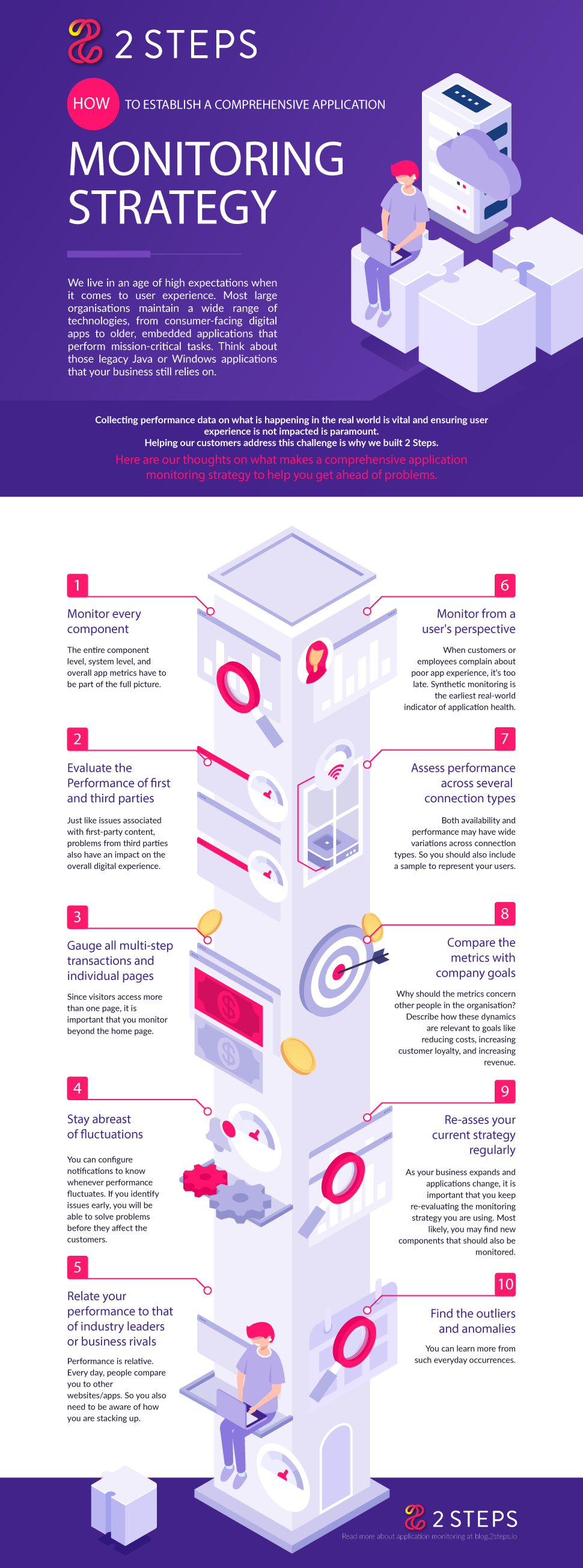Monitoring your entire IT infrastructure alongside the systems may not be easy. It is common for IT departments to react to problems instead of identifying them early enough and prevent disruptions. Considering the importance of avoiding errors and running at optimal performance, companies must monitor their infrastructure proactively.
So, what is application monitoring? How does one pick the most reliable service provider? And what does it take to achieve an effective strategy for the same? This comprehensive coverage offers all the information and tips you need.
What is application monitoring?
This is a process used to assess whether a software application performs and processes in the expected scope and manner. You can use the technique to routinely identify, measure, and evaluate the application's performance. It also offers the necessary steps for isolating and rectifying any shortcomings or abnormalities.
The process is also known as application performance management or application performance monitoring. It lets you know whether your service is fast, slow, down, up, or functioning as designed. In case something breaks inevitably, monitoring tools can immediately notify you through alerts. They can also help in the diagnosis of the problem as well as in offering useful insights for decision-making. Other benefits of the process include:
- Protection of your brand, revenue, and security
- Identifying any issues before they affect your operations
- Generating feedback loops and stability
- Gathering usability and usage data
- Collecting data from real users
- Enabling data-driven decisions and insights
- Improvement of performance and productivity
- Helps in planning and budgeting for IT upgrades
Consideration factors when looking for the best vendor
Every vendor (including us) has its own set of advantages and setbacks. When you look around, you will find that almost all service providers promise to offer the best experience, and you may end up picking a solution provider that would end up disappointing you. Therefore, it is advantageous if you know how to pick the best vendor, and the main attributes to look out for.
Check if your next vendor has the following features:
- Multiple channels – One important consideration factor when choosing a vendor is versatility across different unique platforms. Most service providers can handle Chrome. Some can handle other web browsers such as Internet Explorer and Safari. But the best service provider should run seamlessly as well on Android, Linux, Windows, Java, and other unique application pipelines.
- No code necessary – Some vendors will require you to install an agent or script in your application. Fortunately, agentless synthetic monitoring is becoming the new standard and soon you won't need to install any strange code on your application.
- Splunk integration – All operations should be fed straight into the amazing Splunk dashboard. This relieves you from using multiple dashboards, and you can get all insights on the normal app management screen. Furthermore, your vendor should use IFFTT triggers, toolkits, and machine learning to send the testing feed to other apps.
- Video replay for any app issue – Sometimes, explaining problems your users are experiencing to individuals not familiar with IT development may not be easy. Check if your vendor has video replays of any problems within the application. This offers clear failure mappings and insights into application behaviour.
How to establish a comprehensive application monitoring strategy
We are living at the age of complex applications where components are delivered by physical data centres, the cloud, CDNs, and APIs. So you may miss several issues by just monitoring the content you deliver and the infrastructure alone. But you can test the additional dependencies as well by synthetic monitoring from locations distributed across the globe.
Collecting data for monitoring is the simple part. The greatest challenges are determining the information to collect and ensure that you include all viewpoints. So, how do you achieve a comprehensive strategy? Here are the effective tips:

- Monitor every component. The entire component level, system level, and overall app metrics have to be part of the full picture.
- Evaluate the performance of first and third parties. Just like issues associated with first-party content, problems from third parties also have an impact on the overall digital experience.
- Gauge all multi-step transactions and individual pages. Since visitors access more than one page, it is important that you monitor beyond the home page.
- Stay abreast of fluctuations. You can configure notifications to know whenever performance fluctuates. If you identify issues early, you will be able to solve problems before they affect the customers.
- Relate your performance to that of industry leaders or business rivals. Performance is relative. Every day, people compare you to other websites/apps. So you also need to be aware of how you are stacking up.
- Monitor from a user's perspective. For the broadest coverage, ensure you capture the dynamics from real users. You can use the locations to determine the areas to capture synthetic measurements.
- Assess performance across several connection types. Both availability and performance may have wide variations across connection types. So you should also include a sample to represent your users.
- Compare the metrics with company goals. Why should the metrics concern other people in the organisation? Describe how these dynamics are relevant to goals like reducing costs, increasing customer loyalty, and increasing revenue.
- Re-asses your current strategy regularly. As your business expands and applications change, it is important that you keep re-evaluating the monitoring strategy you are using. Most likely, you may find new components that should also be monitored.
- Find the outliers and anomalies. You can learn more from such everyday occurrences.
Bottom line
Whether you are a service delivery or IT manager, you may encounter lots of pressure to improve efficiencies and deliver seamless performance. By learning both the characteristics and dynamics of your systems or infrastructure, you can detect any issues and risks before they affect your company operations. Furthermore, you can maintain peak performance by learning from previous trends and behaviours. If you regularly manage and monitor your IT environment, you will be in a position to make informed choices.
Do you need insights into how different changes could affect your operations, customer experience, and bottom line? Are you looking for professional application monitoring assistance to streamline your activities? Contact us today and get all the help you need.


